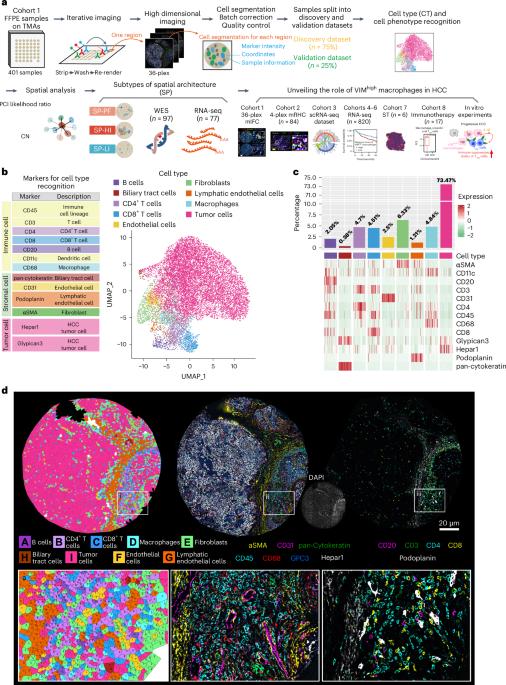空间单细胞蛋白图谱揭示了高波形蛋白巨噬细胞在肝癌微环境中的免疫抑制作用。
IF 28.5
1区 医学
Q1 ONCOLOGY
引用次数: 0
摘要
肝细胞癌(HCC)肿瘤微环境异质性的空间单细胞分辨率尚不明确。在这里,我们通过索引进行了联合检测,用 36 个生物标记物对 401 个 HCC 样本的空间异质性进行了剖析。通过解析肝癌的空间肿瘤生态系统,我们发现了具有不同预后、基因组和分子特征的空间模式,并揭示了高波形蛋白(VIM)巨噬细胞的渐进作用。对八个独立队列的整合分析表明,VIM 高巨噬细胞和调节性 T 细胞的空间共存促进了肿瘤的进展并有利于免疫治疗。功能研究进一步证明,VIMhigh 巨噬细胞通过从机理上增加白细胞介素-1β的分泌来增强调节性T细胞的免疫抑制活性。我们的数据深入揭示了肿瘤微环境结构的异质性,并揭示了VIMhigh巨噬细胞在HCC进展过程中的关键作用,这为个性化癌症预防和药物发现提供了潜力,并加强了解决癌症治疗的空间信息特征的必要性。本文章由计算机程序翻译,如有差异,请以英文原文为准。

Spatial single-cell protein landscape reveals vimentinhigh macrophages as immune-suppressive in the microenvironment of hepatocellular carcinoma
Tumor microenvironment heterogeneity in hepatocellular carcinoma (HCC) on a spatial single-cell resolution is unclear. Here, we conducted co-detection by indexing to profile the spatial heterogeneity of 401 HCC samples with 36 biomarkers. By parsing the spatial tumor ecosystem of liver cancer, we identified spatial patterns with distinct prognosis and genomic and molecular features, and unveiled the progressive role of vimentin (VIM)high macrophages. Integration analysis with eight independent cohorts demonstrated that the spatial co-occurrence of VIMhigh macrophages and regulatory T cells promotes tumor progression and favors immunotherapy. Functional studies further demonstrated that VIMhigh macrophages enhance the immune-suppressive activity of regulatory T cells by mechanistically increasing the secretion of interleukin-1β. Our data provide deep insights into the heterogeneity of tumor microenvironment architecture and unveil the critical role of VIMhigh macrophages during HCC progression, which holds potential for personalized cancer prevention and drug discovery and reinforces the need to resolve spatial-informed features for cancer treatment. Qui et al. perform co-detection by indexing profiling of 401 hepatocellular carcinoma patient samples and identify a role for vimentinhigh macrophages in instructing an immune-suppressive microenvironment by enhancing the suppressive activity of regulatory T cells via interleukin-1β.
求助全文
通过发布文献求助,成功后即可免费获取论文全文。
去求助
来源期刊

Nature cancer
Medicine-Oncology
CiteScore
31.10
自引率
1.80%
发文量
129
期刊介绍:
Cancer is a devastating disease responsible for millions of deaths worldwide. However, many of these deaths could be prevented with improved prevention and treatment strategies. To achieve this, it is crucial to focus on accurate diagnosis, effective treatment methods, and understanding the socioeconomic factors that influence cancer rates.
Nature Cancer aims to serve as a unique platform for sharing the latest advancements in cancer research across various scientific fields, encompassing life sciences, physical sciences, applied sciences, and social sciences. The journal is particularly interested in fundamental research that enhances our understanding of tumor development and progression, as well as research that translates this knowledge into clinical applications through innovative diagnostic and therapeutic approaches. Additionally, Nature Cancer welcomes clinical studies that inform cancer diagnosis, treatment, and prevention, along with contributions exploring the societal impact of cancer on a global scale.
In addition to publishing original research, Nature Cancer will feature Comments, Reviews, News & Views, Features, and Correspondence that hold significant value for the diverse field of cancer research.
 求助内容:
求助内容: 应助结果提醒方式:
应助结果提醒方式:


